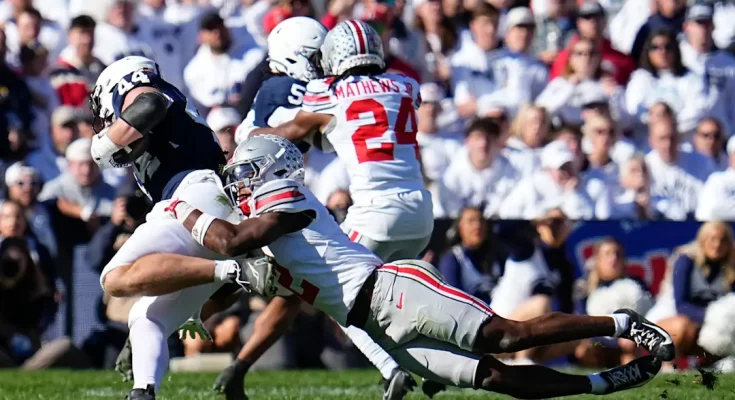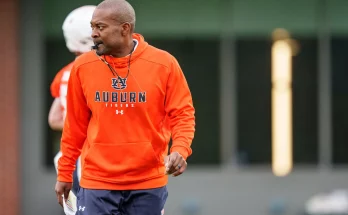The reported kickoff time for the PSU game again puts the Ohio State football team in a difficult situation.
The 2025 college football season hasn’t even begun, and already one of its premier matchups is drawing controversy not for player injuries or coaching drama, but because of something far more subtle yet significant: kickoff time. The announced kickoff time for the Ohio State vs. Penn State (PSU) game is once again placing the Buckeyes in a challenging position, a familiar frustration for both the team and its fan base. Though it might seem like a minor detail to outsiders, game timing can have substantial ramifications on player performance, fan experience, and the overall trajectory of a team’s season.
Ohio State and Penn State have produced some of the most iconic matchups in Big Ten history. The games are intense, physical, and often carry significant postseason implications. Naturally, the networks want these games in primetime to capture national audiences and maximize advertising revenue. Yet for Ohio State, playing PSU in a night slot—especially at Beaver Stadium presents recurring issues, particularly when it comes to atmosphere, recovery, and preparation for subsequent games.
When news broke that the 2025 Ohio State Penn State game would once again have a primetime kickoff at Beaver Stadium, reactions were swift. Players and coaches may not publicly criticize scheduling, but behind closed doors, the sentiment is often one of frustration. Beaver Stadium’s “White Out” night games are legendary and among the most daunting experiences in all of college football. For a visiting team, the deafening noise, freezing temperatures, and raucous environment are far more difficult to endure after dark. It is one thing to face Penn State during a sunny afternoon in October; it’s another to do so under the lights, with 110,000 fans clad in white screaming for four quarters.
The competitive advantage this gives Penn State can’t be overstated. Since the inception of the White Out tradition in 2004, PSU’s win percentage in night games at home has been significantly better than in early games. They feed off the crowd, and Ohio State arguably the biggest villain in their eyes brings out maximum energy. Ohio State has still managed to win several of these night games, but often with great difficulty and not without cost. The elevated intensity increases the physical toll on players, and recovery time becomes a factor for the following week. That’s not just anecdotal it has impacted game outcomes in subsequent matchups.
For instance, when Ohio State played at Penn State in 2022, it was a brutal affair that required a fourth-quarter comeback. The physical and emotional exertion left the Buckeyes drained, and while they pulled off the win, it arguably contributed to fatigue that affected their play in the back half of the season. These are the subtle factors that define championship-level seasons. It’s not just about who you play, but when and where—and in Ohio State’s case, what time.
Additionally, from a logistical standpoint, late games on the road present challenges for player health and recovery. After finishing a night game, teams often don’t return to campus until well into the early morning hours. Players then have to begin the recovery process from a physically exhausting contest on little rest. That’s further complicated by Ohio State’s typically strong schedule. Rarely do they get a “cupcake” opponent after Penn State. In many years, it’s a gauntlet of back-to-back marquee games.
Beyond the players and coaches, fans and families are also affected. Traveling fans have a much harder time attending late games especially in remote or rural college towns like State College, Pennsylvania. Driving back after a 7:30 or 8:00 p.m. game means arriving home in the middle of the night or even the next morning. For those with children, jobs, or early obligations, it becomes a near-impossible task. Not to mention the financial toll of hotels and extended travel required due to the late timing.
Media scheduling is another point of contention. While the networks chase prime ratings, it sometimes comes at the expense of competitive fairness. Ohio State, being one of the most recognizable brands in college football, is often targeted for late-night games because they attract large audiences. But this popularity is becoming a double-edged sword. Their consistent exposure and success make them a frequent candidate for challenging time slots, while other top programs are shielded more often from late games due to conference rules or stronger home-field negotiating positions.
The Big Ten itself has acknowledged the concerns around late kickoffs, especially as the conference expands its reach across time zones with the additions of USC, UCLA, Oregon, and Washington. Games in 2025 will already be complex due to travel demands and scheduling constraints, and now with the OSU-PSU game being cemented as another night battle, the issue is again under the microscope. The question remains: should marquee teams be subjected to the same time slot expectations year after year, especially when it demonstrably affects their season flow?
Critics might argue that Ohio State should simply adjust and accept the spotlight that comes with being a powerhouse program. After all, this is the reality of big-time college football. But parity and balance are foundational to competitive sports. If one team is regularly placed in more difficult conditions be it scheduling, travel, or timing it creates an uneven playing field. Nobody is saying Ohio State should avoid primetime altogether, but rotating the time slots more fairly across top matchups would go a long way in preserving competitive integrity.
Players, especially those with NFL aspirations, are already under immense pressure to perform at a high level each week. Adding extra challenges due to scheduling quirks only increases the likelihood of injuries or underperformance. Coaches must also adjust their weekly preparation schedules, meal plans, sleep cycles, and practice intensity to accommodate late games. These aren’t minor tweaks they are full-fledged strategy shifts that affect everything from film study to medical treatment.
It’s worth noting that Penn State doesn’t face this issue as frequently when visiting Ohio Stadium. More often than not, the Buckeyes’ home games against PSU are played in the afternoon or early evening. The difference may seem slight on paper, but the psychological and environmental gap between a 3:30 p.m. kickoff in Columbus and an 8:00 p.m. White Out in State College is night and day literally and figuratively. It raises questions about fairness and consistency in marquee game scheduling.
The pressure on Ohio State is even greater in 2025 due to heightened expectations. With a stacked roster, returning veterans, and a coaching staff that has its sights on a national title, every detail of the season matters. From recovery windows to mental preparation, the margin for error is razor thin. Even one slip-up—perhaps in a hostile late-night game can derail championship dreams.
As fans continue to voice frustration on social media, some have even floated the idea that Ohio State should push back harder against these decisions, possibly even leveraging its influence to gain more favorable slots. Others suggest the Big Ten needs a stronger internal scheduling policy to prevent one team from consistently bearing the burden of challenging game times. Whether or not those changes come remains to be seen, but the conversation is intensifying.
In the grand scheme of things, kickoff times may seem trivial compared to talent, play-calling, and execution. But when a team consistently faces the same disadvantage particularly one rooted in environmental and scheduling factors the impact accumulates. For Ohio State, the 2025 PSU game is just the latest chapter in a long-running story of battling not only opponents, but also the schedule makers. And once again, they’ll have to prove that they can win under the lights, in enemy territory, against all odds.



